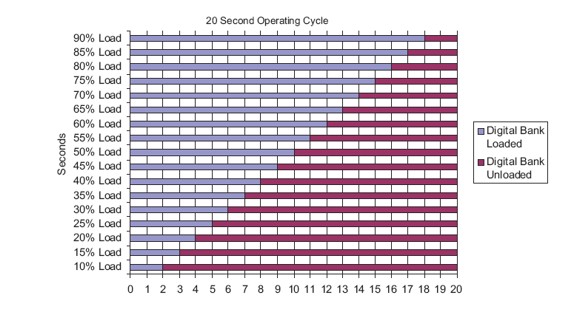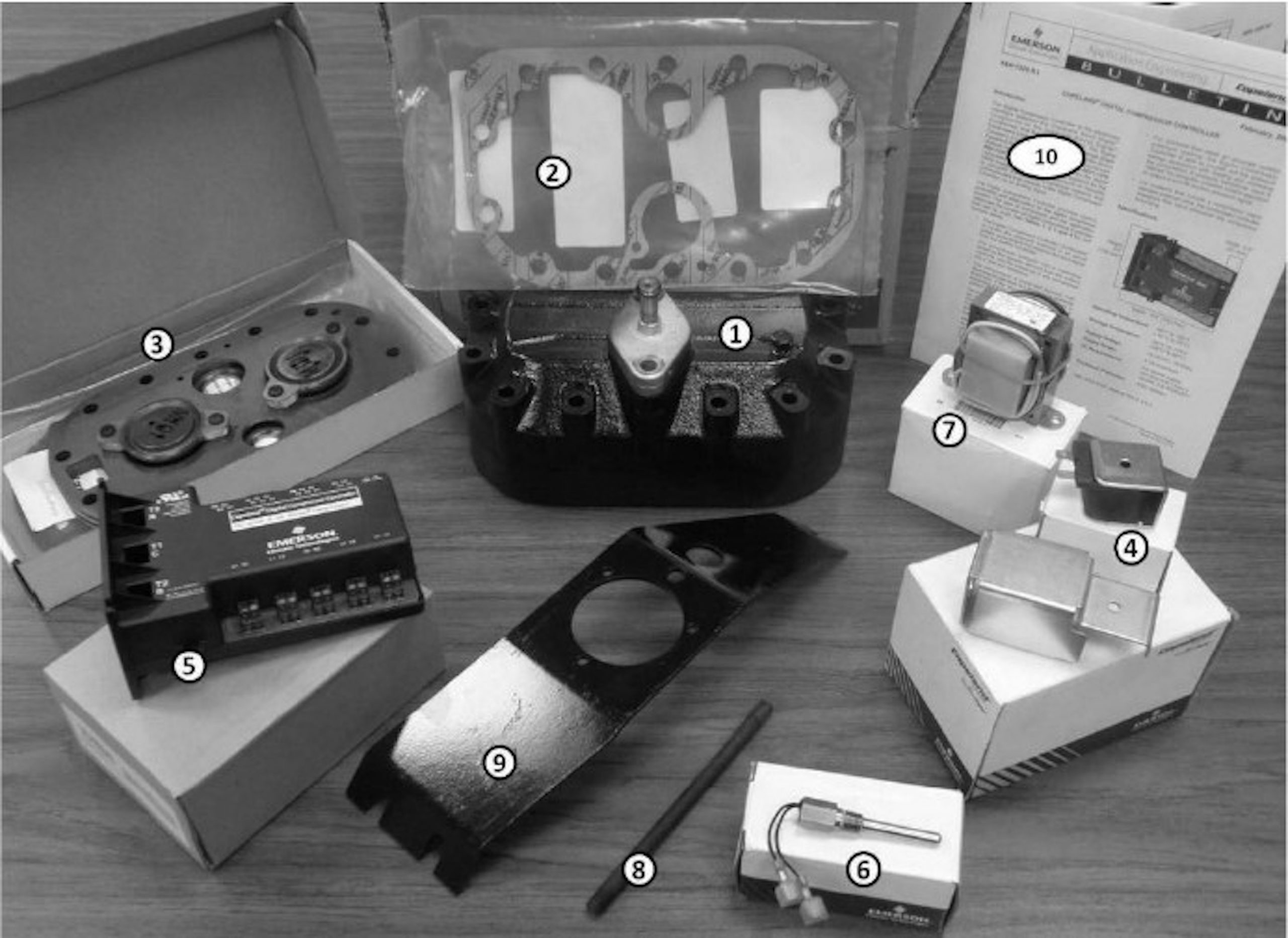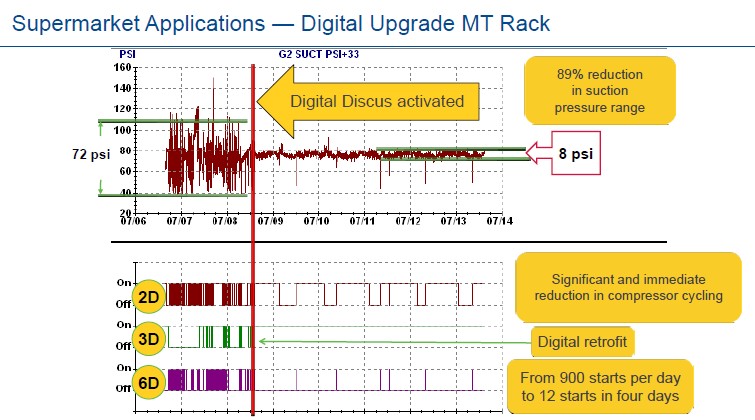
Compressor Retrofits for All Seasons
June 29, 2021 | By Dave Demma
Embracing the digital age for compressor efficiency.
Regardless of the type of refrigeration system, the compressor’s function is always the same—it’s a volume pump, receiving low pressure/low temperature vapour, and compressing into a high pressure vapour. Compressor capacity is based on the following: compressor displacement; compressor efficiency; thermodynamic properties of the refrigerant in use; and system conditions (SST, SCT, liquid temperature, suction vapour temperature, etc.)
Compressors are selected for an application’s design condition, which will be the worst-case scenario in the middle of the summer. This will ensure that the compressor has sufficient capacity to achieve the temperature requirement in the refrigerated space, even under the most adverse of conditions.
Ever Changing Capacity
One factor in determining compressor capacity is the system conditions. Not surprisingly, conditions are constantly changing, particularly the ambient temperature, which then affects the condensing temperature. There can be wide variations in ambient between early morning and late afternoon, summer-fall-winter-spring, all resulting in capacity variations.
Ever Changing Load
Following are some of the many circumstances which result in changes to the refrigeration load:
- Display case doors being opened
- Walk-in box doors being opened
- Display cases and walk-in boxes being restocked with warmer product
- Systems cycling off when temperature set-point is achieved
- Systems cycling off for defrost period
- Head added to refrigerated space from electric/gas defrost
In order to maintain the design refrigerated space temperatures, yet not operate with excess capacity, the typical multi-compressor supermarket rack is comprised of compressors of varying size/capacity. Compressors are staged by the system controller to meet the load demand at any given moment. Even with this level of variable capacity, it is unlikely that there will be sustained periods of time when the compressors in operation will precisely meet the load demand.
As a result, compressors are cycling off/on all day long, which will ultimately reduce compressor life, compressor contactor life, and increase power consumption.
The problem: standard compressors operate at either 0% capacity (off), or 100% capacity (on). The solution: use a compressor with variable capacity.
Mechanical cylinder unloading in reciprocating compressors is not a new concept. It typically allows for one cylinder bank to “unload”—a process which prevents that bank of cylinders from compressing vapour. This method doesn’t offer the flexibility required to precisely match the compressor capacity with the refrigerated load.
Now, if the precise and repeatable actions offered by digital control were to be paired with the mechanical unloading process, what then?
Copeland Digital Scroll
The digital scroll differs in design from the standard scroll in that the top scroll plate has the ability to “lift” approximately 1-mm from its normal position—enough to eliminate the scroll plate’s ability to compress vapour. The result is 100% unloading capability.
This is where the “digital” part comes in. The digital controller which initiates the unloaded mode can now operate in segments of “cycle time.” Plainly speaking, the compressor operation can be broken down into cycles of 20 seconds, with some portion of the 20 seconds operating completely loaded, and some portion unloaded (See Figures 1 and 2).

Figure 1. Compressor loading/unloading in 20 second segments.
The capacity of the digital scroll can vary between 10% and 100%. The compressor capacity can be calculated from a ratio of percentage of loaded state time to the total cycle time. For example, if the loaded state time were 10 seconds, and the total cycle time were 20 seconds, the compressor capacity would be 10/20, or 50% of total capacity. Given the wide range of capacities with which the digital product can operate under it can offer a very precise solution for matching the compressor capacity with the system load. Not only can design parameters be maintained more closely, but there is the added benefit of energy savings, all thanks to the digital age we live in.

Figure 2. Compressor unloading capabilities. Compressor can operate unloaded in the context of 20 second segments anywhere from two seconds loaded (10% loaded) to 18 seconds loaded (90% loaded), providing a much broader capacity range as compared to traditional mechanical unloading.
Digital Discus
The same technology has been applied to Copeland’s discus compressors. The unloading is accomplished by blocking the suction port of the given cylinder to be unloaded.
This allows the bank of cylinders controlled digitally to operate anywhere from 10% to 100% capacity. If it’s a three-cylinder compressor (3D model), the cylinders will constitute a single bank, and will load or unload simultaneously. The four-cylinder (4D model) and six-cylinder (6D model) compressors will have one bank of cylinders that remain 100% loaded at all times. As such, the 4D will unload to 50% and the 6D down to 33%.
One of the benefits of the semi-hermetic compressor, with removable heads and valve plates, it allows one to upgrade a standard discus compressor to a digital discus compressor.

Figure 3. Conversion to digital discus: 1&2) digital head assembly/gaskets; 3) digital valve plate; 4) solenoid coil; 5) compressor controller; 6) sensor temp. probe; 7) 24V transformer; 8) head stud; 9) fan bracket; 10) instructional sheets.
The retrofit involves: replacing existing lead scroll compressor with a digital scroll compressor; replace existing lead semi-hermetic reciprocating compressor with a digital discus compressor; and convert the existing lead semi-hermetic discus to a digital discus compressor (see Fig 3)
In each case, the compressor replacement/conversion will require the addition of a digital compressor controller, and configuring the central rack controller to provide the necessary signal to the digital compressor controller for proper loading/unloading operation.

Figure 4. The benefits of converting to either a digital scroll or digital discus compressor.
Figure 4 shows the benefits of converting to either a digital scroll or digital discus compressor in a supermarket application: more consistent/stable suction pressure; reduction in compressor cycling; corresponding reduction in incidents of compressor inrush current; and corresponding increase in compressor contactor life
This article gives a brief overview of the concept and benefit in utilizing digital scroll/discus unloading capabilities. The Application Engineering Bulletins from Copeland provide more in-depth detail regarding the understanding, application, set-up and capabilities of the digital scroll/discus compressors.
The Bulletins can be found at www.emersonclimate.com in the online product information.

 Dave Demma has a degree in refrigeration engineering and worked as a journeyman refrigeration technician before moving into the manufacturing sector where he trains contractor and engineering groups. ddemma@uri.com.
Dave Demma has a degree in refrigeration engineering and worked as a journeyman refrigeration technician before moving into the manufacturing sector where he trains contractor and engineering groups. ddemma@uri.com.


